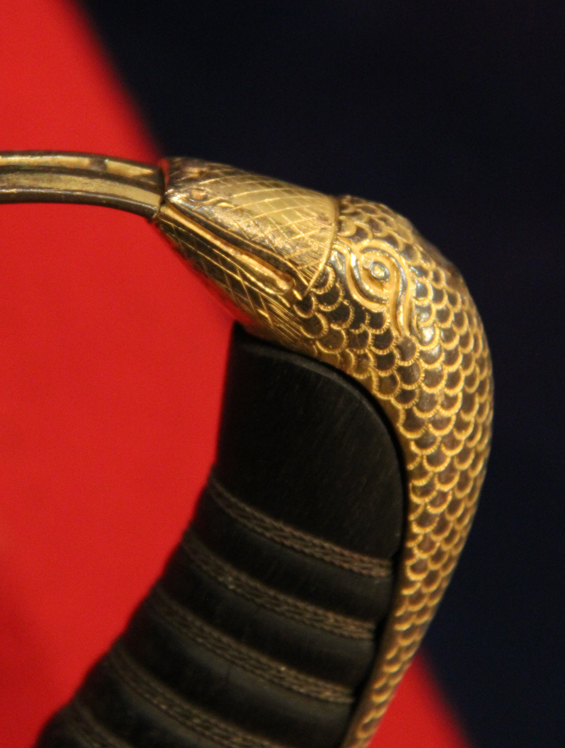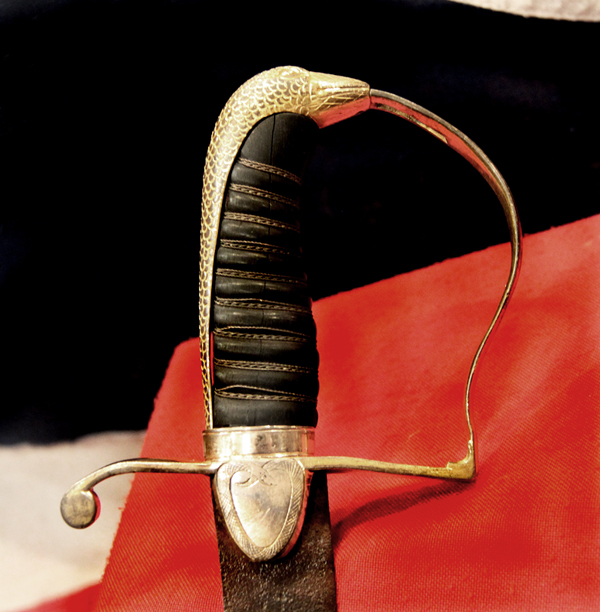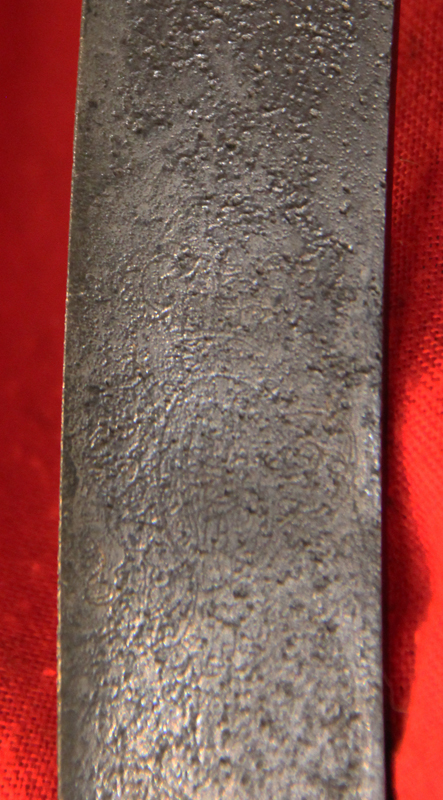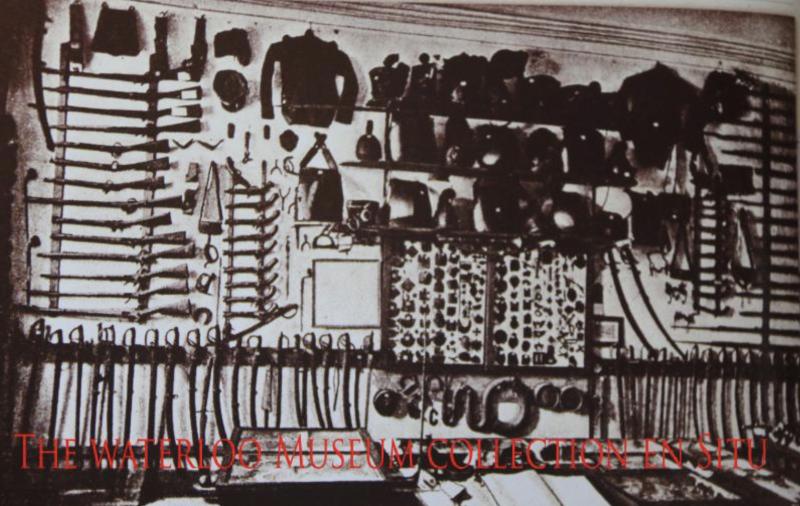A Most Rare British Army Officer's 1801, Egyptian Campaign, Snake Goddess' Head Light Infantry Officer’s Sword. Used Throughout The Entire Napoleonic Wars Up To The Battle of Waterloo. Likely By An Officer of ‘The Glosters’
Specifically with British Army ‘Nile Club’ officer's connections, where officer members, who fought in the Egypt campaign, wore distinctive swords with zoomorphic hilts depicting animal gods and goddesses. A direct homage to Nelson's presentation zoomorphic hilted sword, dirk and sword versions of Nelson’s zoomorphic sword, as worn by his captains who served under his command, and by the marines and army officers who similarly fought in his Egypt campaign on land over the next three years, that were members of the so-called Egyptian or Nile Club. The wearing of such a sword {or a dirk} would clearly and distinctively set an officer apart as ‘one who served’ in the great hero’s victorious campaign.
Egyptian gods and goddesses, much famed in ancient Egypt, become hugely popular throughout Western artistic culture in the early 19th century.
Europe became beguiled by ancient Egyptian art and architecture in all its forms, and furniture designers and sculptors particularly, eagerly created the ‘Egyptian style’ in the Regency period England, and the Consular and Directoire period in France.
This is a most rare British officer's bespoke sword, commissioned circa 1800, with such a stylish hilt, of a rare, zoomorphic, ancient Egyptian animal god or goddess form, with its snake god head pommel, with engraved snake-scale body creating its back strap, plus, the Egyptian snake goddess Wadjet's form, as engraved hilt langets. This sword is based on the British 1796 pattern light infantry variant sabre, with its deeply curved slashing blade, superbly etched with King George’s royal cyphers. This sword was continually used throughout the Napoleonic Wars, and up to Waterloo in 1815. Very likely by an officer of ‘The Glosters” the 28th Regiment of Foot. No doubt the fact that the Goddess Wadget was the Ancient Egyptian symbol of divine authority and royal power likely had no small influence upon its choice of design.
In 1801 On the morning of March 21 a vastly superior French army, which easily outnumbered the British, attacked near Alexandria. By those times muzzle-loading rifles were in common use and the infantry fought in two ranks - one row kneeling and the rear rank firing over their shoulders.
At one point during the fierce fighting -when it looked as though the Glosters would be surrounded - the rear rank was commanded to "about face". This meant turning and fighting back-to-back against enemy soldiers coming from the rear. After much savage hand-to-hand combat the French were stopped and by mid-morning their entire army was in retreat.
As a reward for their vital contribution to the victory - and in memory of that back-to-back fighting - the Glosters were given the right to wear a badge at the back, as well as the front, of their caps - the famous sphinx Back Badge.
Napoleon's army in Egypt may have been defeated but on the European mainland his forces remained a serious threat. By 1810 both the 28th and 61st were in Spain with the task of clearing French troops from the entire Peninsular.
But it took another four years of difficult fighting - in which the Glosters lost 1,200 men - before the British, under the command of the "Iron" Duke of Wellington, finally expelled them.
In 1814, Napoleon, having escaped from Elba, once more rallied troops to his cause and the European allies - under the command of the Duke - were sent to face him.
In the summer of 1815, Napoleon was finally defeated at Waterloo and exiled to the island of St Helena. The Glosters were in the forefront of the fighting - and were the only regiment specifically mentioned by name in Wellington's famous despatch.
With a beautiful zoomorphic hilt, with its original mercurial gilt finish, of a beautifully chiselled and hand engraved snake's head and body, combined with two snake engraved langets, with its wire bound wooden grip, and deeply curved now russetted blade bearing King George IIIrd's cyphers. Deep sword cuts from close combat action on the blade edge and upon one langet. Combat damage inflicted likely in the Peninsular War up to Waterloo. Nelson's captains at the Nile formed the Egyptian Club often though referred to as the Nile Club to meet and commemorate the battle. Among their first actions were to present a sword to Nelson and commission his portrait. There were also weapons made, based on the one presented to Nelson, for the other members of the Egyptian Club, that had zoomorphic hilts in the form of crocodiles.
At the instigation, it is said, of Lady Hamilton and Captain Hardy, the Marquess of Queensbury laid out a plantation of trees on his estate near Stonehenge in Wiltshire in the formation of the fleets at the Battle of the Nile, known as the ‘Nile Clumps’. A ceremonial sword with its hilt in the shape of a crocodile commemorating Nelson's victory over the French at the Battle of the Nile in 1798, which was estimated at £40,000 to £60,000, sold at auction in 2002 for £270,650 to a private collector.
The engraved sword was one of a handful made for the elite Egyptian Club whose membership was restricted to the captains of ships which had fought at the Nile. Nelson called them his "band of brothers". However, Howard Blackmore late assistant keeper of the Tower of London Collection told us around 30 years ago, that there was a distinct possibility British army officers, that also fought at the Nile Campaign, but of course on land, formed their own version of Nelson's Egyptian Club, called the Nile Club, where officers in the campaign had zoomorphic Egyptian snake or camel hilted swords presented to each other. The snake hilted version were based on the snakes of the ancient Egyptian Goddess Wadjet, and the snake head on the Pharaoh's crown. There is a distinct possibility that this sword may well be one of those, its rare shape and form certainly shows as likely. We have heard of one serving example now in America, a Nile club officer’s sword with a zoomorphic camel head hilt. Its likely possibilities of provenance are most intriguing. Five years ago also we had a British camel headed version likely from the same club member. The French Campaign in Egypt and Syria (1798-1801) was Napoleon Bonaparte's campaign in the Ottoman territories of Egypt and Syria, proclaimed to defend French trade interests, weaken Britain's access to British India, and to establish scientific enterprise in the region. It was the primary purpose of the Mediterranean campaign of 1798, a series of naval engagements that included the capture of Malta.
On the scientific front, the expedition eventually led to the discovery of the Rosetta Stone, creating the field of Egyptology. Despite many decisive victories and an initially successful expedition into Syria, Napoleon and his Armee d'Orient were eventually forced to withdraw, after sowing political disharmony in France, experiencing conflict in Europe, and suffering the defeat of the supporting French fleet at the Battle of the Nile.
The last time we saw an Egyptian Club Zoomorphic crocodile hilted sword sold was at Sotheby's in 2020, estimated at £60,000 to £80,000 gbp, but the blue and gilt to the blade was present and it had its scabbard.
The second to last photo in the gallery is of a painting of ‘The Glosters’, that fought at Waterloo.
The last photo in the gallery shows a photograph of one section of the collection in the museum of Waterloo, taken in around 1900, showing all the weapons of Waterloo en situ, including all the protagonists {British, French, Prussian and Belgian muskets, swords, pistols, armour uniforms, etc}. The museum was founded and owned by a veteran of the 7th Hussars that fought at Waterloo
No scabbard.
Code: 22179
1750.00 GBP










